Candling Eggs is an easy process that gives you assurance that your eggs are fertile and developing correctly after a short period of time in the incubator. It allows you to remove infertile eggs and soon you will start to be able to identify ‘bad eggs’ and remove these as well. The candling photos on this page should help you to identify these.
Although it has never happened to me, bad eggs can sometimes explode or ooze in the incubator causing bacteria to contaminate the other good eggs, causing them, in turn to go bad.
I usually candle my eggs after a week of incubation. It can of course be done before this but the first week of incubation is the most critical in terms of getting the correct development of the embryo so leaving the eggs alone during this time is good practice. After a week, we are a third of the way through incubation and it is far easier to identify fertile eggs, even if eggs have a dark shell as is the case with Marans.
How to candle eggs
You will need a bright light and a way of shining this through the egg. Candlers can be bought online from poultry shops, or you can make one using a bright light and a cardboard box with a hole cut out for the egg to sit on. Try to get the best seal around the hole and candle in a dark room to see the best results.
Candling Dark Eggs
If the shells are dark or have pigments / marks on them, it can be difficult seeing the embryo. I rock the egg from side to side very gently so the contents move. This must be gentle, or you risk damaging the Chalazae that hold the yolk / developing embryo.
“The Chalazae is the structure that suspends the yolk within the egg. It can be damaged by shocks and vibration”
Remember not to candle for too long if it is heating the egg. I spend around 8 seconds per egg before trying the next one.
What to look for after a week
After 7 days, you should be able to see development of the embryo, including spider like veins and even (if you are lucky) a little movement. The embryo often sits on one side of the egg so be sure to rotate the egg around slowly to get the best view. Occasionally, you may see a tiny heart beating if it is close to the edge of the shell.
Look for fertile and non fertile eggs. Clears as they are called are easy to remove after 7 days. If you have a number of eggs in the incubator, it soon becomes clear which eggs have developed correctly.
By day 7, you should clearly see the embryo. Don’t forget to turn the lights out in the room when you do this so you get a clearer picture!
What to look for after two weeks
After 14 days, the embryo is well developed and turning into a chick. Two thirds of the egg is now covered and it is hard to see any detail.
Look for embryos that have developed so far but died. This can be for a number of reasons, including incubation technique, damage to the chalazae (which can happen when eggs are dropped / damaged in the postal system for example) or become infected with bacteria. A red ring is sometimes seen inside the egg which is the bacterial infection.
The photo to the right shows how much of the egg is now filled with the embryo / soon to be chick. It is more common to see movement inside the shell.
Bad Eggs
If an egg appears bad, it can be removed to prevent it from exploding and contaminating other eggs. Bad eggs can look different every time but if you compare them to the bulk of the other good eggs in the incubator, it won’t be long before you can recognise a bad egg from the rest. The bad egg shown to the right was found at day 14, two weeks into incubation. Clearly comparing this to our last photo, there is a problem.
Bad eggs don’t change – so if you are unsure, mark it and have another look a few days later to see if it still looks the same.
The second photo shows to the right shows the contents of this bad egg after it was opened on a plate. I wouldn’t normally do this because it can be smelly but was worth while to show what the contents looked like, clearly not a nearly developed chick!
There are a few more photos on poultrykeeper’s candling chicken eggs page here.

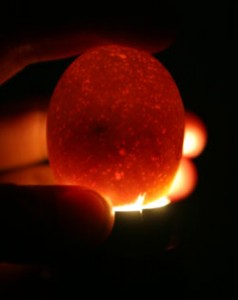
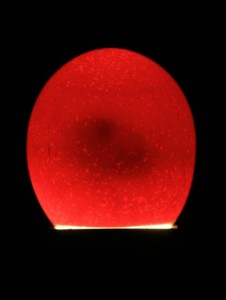
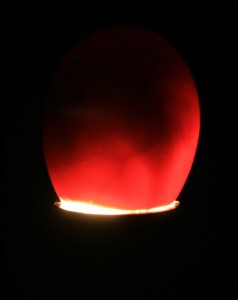
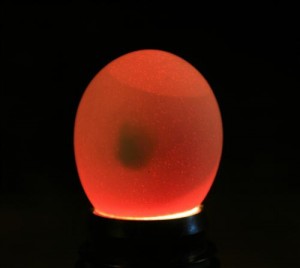
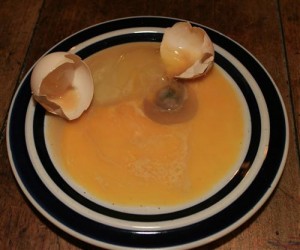



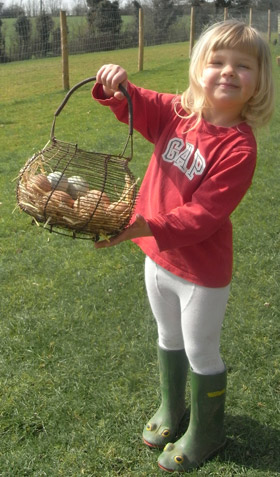

Anyway what are Goldlines and what do you cross to get them do you have photos of them sryy for all the questions but i cant help it sorry
Goldlines are popular in the UK as a hybrid. They may not be available everywhere. They are pretty much the standard hybrid used to produce brown eggs here. In the US they use white Leghorns to produce white shelled eggs as these are preferred by the consumers there.
I think bad eggs picture to me it does not make any difference with seven days old egg therefore at day seven it may be difficult to determine the fertile egg and bad egg
At 7 days, you should see the veins and development but bad eggs have the dark spot. If in any doubt put a ‘X’ in pencil on the suspect eggs and leave them a few more days. You’ll soon see if they continue to develop.
im getting chickens for a project,do the hens have to be with the roosters to lay eggs
No, you don’t need a rooster for a hen to lay eggs.
if you have a rooster how can you tell if there is a chick inside the egg or not like straight away as soon as the hens laid it so u dont eat it?
You can only see if an egg is fertile after it has been kept warm for a while. There is development after 24 hours but to see this through the shell is pretty much impossible the way us chicken keepers do things so we candle after a week when it is far easier to see development.
does it matter what type of bright light you shine in the egg?
No, a flashlight and toilet roll tube work fairly well. As long as you don’t heat the egg with it too much.
hi all need some quick advice, have a very broody hen who has been sitting on eggs for a while. Two days a go one of the eggs hatched and we have a lovely little chick. Since then nothing. the eggs are warm and she is still lovingly sitting on them, chick is fine eating and drinking, what I want to know is when do you call it a day on the other eggs as I wouldnt be happy if I threw away eggs that were close to hatching. Thanks in advance for any advice given x
She will decide when the right time comes along. Chicks can survive for 48 hours from the goodness out of the yolk that is absorbed just before hatching for this reason. She will normally give it a day or two before taking her chicks to food.